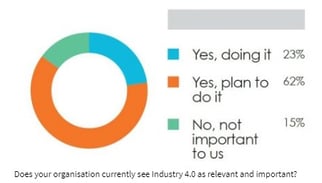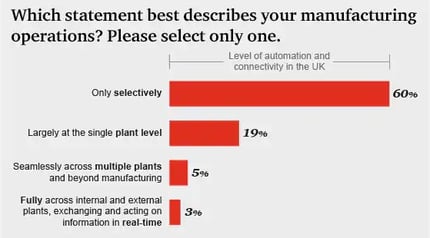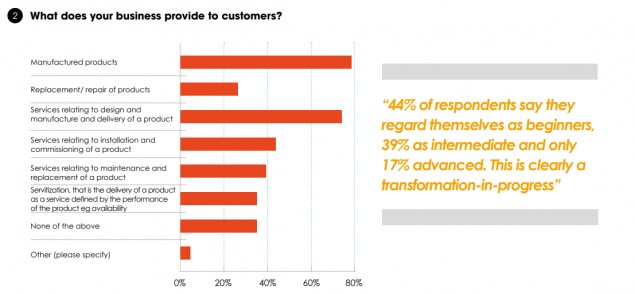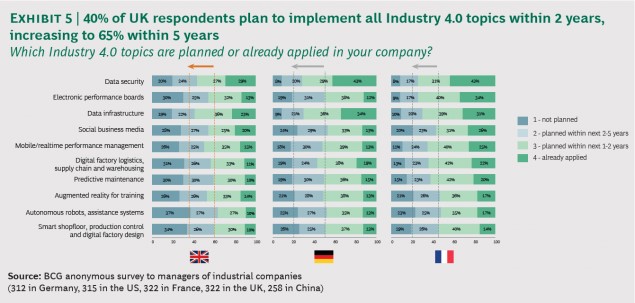 In the UK, more than two-thirds (67%) of respondents in the Annual Manufacturing Report Survey have said that they're 'aware' of Industry 4.0. 23% are already moving over to digitisation and automation of their systems, while 62% are actively planning the move. Source: Annual Manufacturing Report
In the UK, more than two-thirds (67%) of respondents in the Annual Manufacturing Report Survey have said that they're 'aware' of Industry 4.0. 23% are already moving over to digitisation and automation of their systems, while 62% are actively planning the move. Source: Annual Manufacturing Report
And regardless of where they are in the process, all respondents have mentioned making significant investments in automation in 2017-2018, with an understanding that all these major transformations require one very significant piece at the core: A high level of factory connectivity 'exploited to the full'.
But there's room for improvement across Europe. 46% of German companies, for example, report implementing Industry 4.0 technologies (and report feeling confident about their implementations). When compared to the UK's own 25% of manufacturers who report feeling they 'have an adequate understanding of the threats and opportunities of Industry 4.0', there's clearly room for improvement and a need to see the specifics of how to implement these transformations.
Why and How UK Companies Can Extract Benefits From Embracing Digital Transformation
The biggest fear of manufacturing companies – which, in turn, drives deep resistance to this incumbent change – is that automation will make humans obsolete. But, the reality is that automation is already freeing individuals up to diversify the company's products and services, offering corollary options like lease/hire/rental of product. In fact, only 27% of industrial automation leads to a reduction in staff costs.
Now, there are many advantages to be gained from automation, including:
- Improving business efficiency
- Improving quality
- Reduce production hire
- Improvement working environment
- Introduction of new plants
- Freeing up staff to undertake more value-adding tasks
- Achieving plant flexibility
Meanwhile, the outlook and expectations for connectivity within a manufacturing and production setting are equally as bright:

Source: Annual Manufacturing Report
5 Common Principles of Successful Industry 4.0 Implementation
1) Building An Integrated Operations Ecosystem
 Successful implementation of these digital technologies and their supporting principles relies on an integrated operations ecosystem.
Successful implementation of these digital technologies and their supporting principles relies on an integrated operations ecosystem.
When PWC UK took a look at connectivity and automation in current UK companies, they found that it's a 'must-have for companies looking to harvest the full potential of digital, enabling them to improve cost and leverage data analytics'. Instead, a large majority of companies in the UK are currently 'only selectively' exploiting this relationship in their facilities (see image). Source: PWC UK
Implementing an integrated operations ecosystem requires management to put in place a clear strategy for:
- Offering digital products and services
- Operating connected physical and virtual assets
- Transforming and integrating all operations and internal activities
- Building strategic partnerships
- Optimising customer-facing activities using these new technologies (often predictive in nature)
2) Rethinking KPIs and How 'Success' Is Measured
If the platforms are new, and the behaviours are fresh, this means that measurement of ROI and metrics of success need to run alongside this change.
It's no coincidence, then, that the era of Industry 4.0 is coming up with a new kind of focus on metrics: Growth and the North Star. A company's North Star is a pre-determined desirable outcome against which all future activities will be weighed. The only thing that matters is that this North Star is achieved, because it best reflects the company's priorities.
And, of course, these KPIs should always be geared towards growth – be that measured through customer acquisition, investments, market share, revenue, etc. A great example of this is seeing a shift in previous labour-intensive processes that are manual with automated practices that significantly speed up the time in production.
3) Moving to Servitisation
A third common principle for successful implementation is directly related to what we saw with the integrated operations ecosystem.
Servitisation is an inevitable consequence of that transformation. It's all about manufacturers beginning to see themselves beyond the role of just producers of tangible products.
The 'achievement of plant flexibility' we saw previously as an advantage mimics this. In fact, the somewhat unintended effects of servitisation were that:
- 31% of companies found it reduced the overall cost of production
- 22% said it increased the flexibility of production
Servitisation calls on manufacturers to transform 'themselves from sellers of products to deliverers of services' because 'companies [are striving for] new ways to please customers – and hang onto them.' The power of providing a combination of products and services means that companies can diversify their revenue streams, introducing a greater number of ways to serve their clients' or customers' various needs under one brand.

Source: Annual Manufacturing Report
Perhaps the best example of this was Microsoft. Under the leadership of Satya Nadella, the introduction of cloud-based services such as One Drive diversified Microsoft's offerings in 2014 and 2015, at a time when all other flagship products were losing to Apple. The result was that these servitised offerings gave Microsoft one of its most profitable quarters.
4) Rely On Proven IT Security Processes
Digital transformation is innovative, profitable, and advantageous on many fronts. But it's not without its vulnerabilities. Some see the increasing reliance on digital as a gateway to a commensurate rise in cyber-attacks.
While it's true that these attacks are common, there are also a host of precautions companies can take. These proven security implementations must occur alongside these digital transformations.
While some are preventative in nature, equipping manufacturers from the outset, others are designed to be triggered when direct attacks are waged. The point is to extend these IT security processes to production floors, protecting actual plant equipment or practices. This can include strategies like network segmentation and firewalls.
There are also instruments which allow centralised and streamlined command of all connected IoT devices that update simultaneously. As we feel less like beginners and embrace digital transformation, the sophistication of these security techniques is rising in kind.
5) Create a Tangible Timeline for Transformation
 And, finally, there needs to be a tangible timeline for transformation.
And, finally, there needs to be a tangible timeline for transformation.
There are just so many prongs to digital transformation. For this opportunity to be seized by UK manufacturers headed into Industry 4.0, it must be seized correctly, from the outset.
Source: The Boston Consulting Group
Addressing data infrastructure, putting in place digital factory logistics – these are things that cannot be handled in a piecemeal way. That's why it's so important to plan these changes at the same time, addressing what it would mean for internal and external operations.
What are the minuscule human- and machine-related changes that will have to occur?
What are the shifts in business culture that have to organically develop over time?
The hardest thing to remember at the beginning of any transformation – let alone one as fundamental as Industry 4.0 – is that this is a long-term industrial strategy. You're in it until the next natural, inevitable evolution.
For now, UK companies have to bridge the gap between potential and move to practical. Even starting to address the previous four spheres with a concrete timeline will be one giant step for manufacturing-kind.








